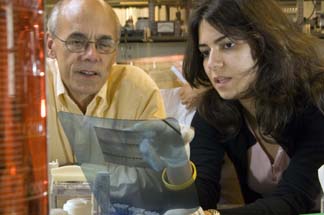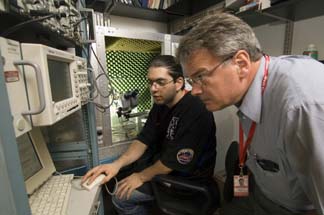Qatari students reap summer of research in the city
By Melissa Hantman '01

NEW YORK -- For the first graduating class at Weill Cornell Medical College-Qatar (WCMC-Q), this summer offered a special way to celebrate a fruitful first year.
Eleven outstanding students in the Class of 2008 at Cornell University's Middle East outpost in Doha were selected to spend the summer in New York City for the first annual eight-week Summer Research Fellowship Program.
In early July, Gary Schneider, senior associate dean for research in Qatar, traveled to Manhattan with the students. Back in Doha, he will organize a forum for the students to discuss their research experience with oral and poster presentations.
"The faculty mentors will give the students a good scientific basis for medical research in the labs," Schneider said.
At WCMC, students were paired with professors in various research departments of the medical college, many of whom had visited Qatar as guest lecturers or taught the students via video streaming.
The steadily growing medical college in Doha, housed in a building the size of two football fields, enrolled 26 students in the Class of 2009, 42 students in the Class of 2010 and 60 in the Class of 2011. The curricula match that at the New York City campus, upholding the same high standards and awarding the same medical degree.
The summer research fellows lived together in apartments on the Upper East Side, socializing with their New York counterparts after work and on the weekends.
Here are some of their comments on the program:
Maryam Shafaee, a soft-spoken student from Iran, devoted her summer to studying the mechanisms of sodium channels in animal models, exploring protein mutations that may be involved in hypertension. This is her first time in the United States. "It's amazing," she said. "I love this city." She worked in the lab of Lawrence Palmer, professor of physiology and biophysics, who had traveled to Qatar for a week for a visiting lectureship, delivering a talk on kidney physiology that sparked Shafaee's interest. "It's amazing how a group of people focus on one special subject, work long hours for a long time and can accomplish something really significant," she said.

Shafaee also worked with Rache Simmons, the Anne K. and Edwin C. Weiskopf Associate Professor of Surgical Oncology, on chart review and data analysis, and she has attended two reconstructive breast surgeries.
Rana Biary from Saudi Arabia believes that WCMC has been in the ideal place to study the renin enzyme, its synthesis and release in mast cells, and its role in inflammation and vasoconstriction. Indeed, she has worked in the very laboratory that made the breakthrough discovery that renin is secreted by mast cells in the heart and lungs, instead of solely from kidney cells.
Randi Silver, associate professor of physiology and biophysics, has spent at least three or four hours a day with Biary going over procedures, research and results. When Silver visited Doha to lecture on physiology, Biary knew she wanted to work in her lab.
"It's not just what you study, it's how you approach it," Biary said. "You have to approach lab work like a logarithm, be very organized and go step by step. It doesn't come intuitively. But it's helped me to become a more dexterous researcher."
Silver said, "Rana has developed some good basic lab skills. She's applied her basic chemistry, making all her own solutions and cell cultures and Western blots, even assisting grad students in calcium imaging, which is very complicated. She's taken an active role in exposing herself to many opportunities."
Subhi Al Aref, a student from Jerusalem, has found a kindred spirit in Olaf Andersen, the Thomas H. Meikle Jr. Professor of Medical Education and professor of physiology and biophysics. Andersen visited Qatar to deliver a lecture that aligned perfectly with Al Aref's interest in biophysiology.
Under Andersen's guidance, Al Aref is investigating the cell plasma membrane and the effects of a specific protein called BDM. In gathering evidence of the protein's effect on cells, Al Aref has found that even small concentrations of BDM have an effect on the elastic properties of the cell membrane's lipid bilayer. The student's finding will be published in a peer-reviewed journal later this year.
"The challenge was, in eight weeks, to come up with a project in which one feels he's making significant contributions," Andersen said. "Subhi has risen to the challenge. That is what you call a hit. To see Subhi and the curiosity and intensity with which he works, I have no doubt that he is going to be a scientist.
"He has good, strong quantitative skills, and that's why he's independent now," his mentor said. "He has been able to take considerable ownership of his project, and you're not really a scientist until you're able to do that.
"These students are pioneers," he said.
Media Contact
Get Cornell news delivered right to your inbox.
Subscribe